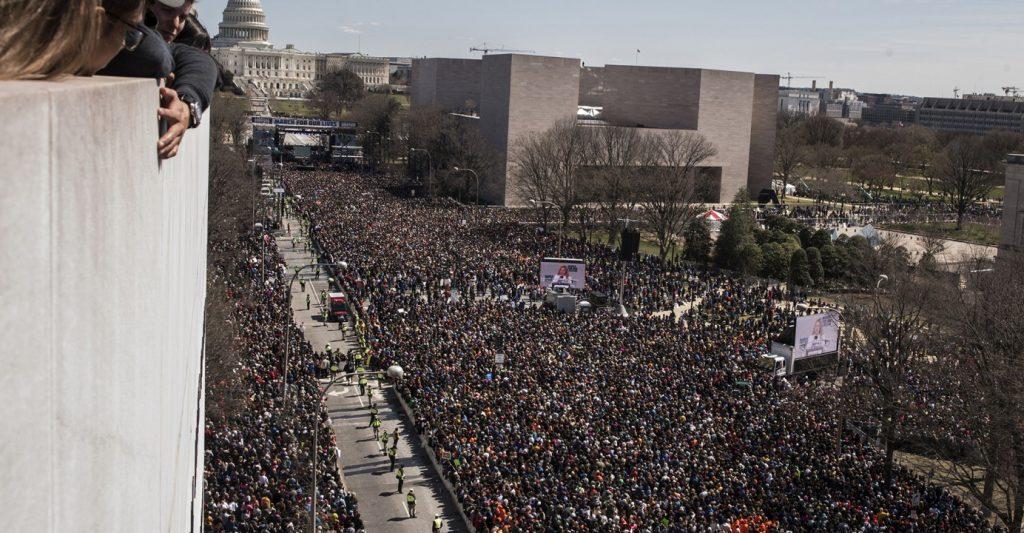Young people energize ‘March For Our Lives’ demonstrators in D.C.
The Daily Iowan; Photo by Ben Al
Tens of thousands converge on Washington for the March for Our Lives protest on Pennsylvania Ave. on Saturday, March 24, 2018. The march was held in protest of gun ownership in America as well as the string of mass shootings in schools as of late. (Ben Allan Smith/The Daily Iowan)
March 26, 2018
With kids in the frontlines fighting for an end to gun violence, “March For Our Lives” demonstrators are feeling their calls to action.
WASHINGTON — The U.S. Capitol dome glistened against blue skies as demonstrators packed Pennsylvania Avenue to plea for lawmakers to end gun violence as “March For Our Lives” protests unfolded across the nation March 24.
The national demonstrations come after the Feb. 14 shooting that killed 17 at Marjory Stoneman Douglas High School in Parkland, Florida. Students from Parkland have since kept both their names and their cause in the headlines, remaining vocal proponents of improved background checks for gun owners, age restrictions for those purchasing guns, and other legislation that would regulate the use of firearms.
The students have urged voters to call upon members of Congress to reject financial contributions from the gun lobby. At the march, the Parkland kids singled out Sen. Marco Rubio, R-Fla., who has benefited from the National Rifle Association spending $3.3 million on his behalf.
Evident among the estimated 800,000 participating was the sense that enough was enough. Chants to “vote them out” echoed from the exteriors of government buildings as the crowd looked on at the stage, which featured Capitol Hill as its backdrop.
Even those who aren’t quite old enough to vote, such as Naomi Wadler, 11, are counting down to when they can cast their ballots. There are just “seven short years” until she can practice her right to vote, the George Mason Elementary School student told demonstrators.
Underlying the frustration was a hint of fear, with one of the most common phrases displayed on demonstrators’ posters asking no one in particular: “Am I next?”
Gwen MccRea, a Virginia resident who grew up in Des Moines and Ankeny, said the kids standing up as activists to fight for common-sense gun laws motivated her to take part in the march. MccRea said she envisions such laws should entail bans on assault rifles, required training for gun owners, and licensing that has to be renewed.
She hopes that politicians will work together to craft legislation that will at the very least slow the rate of gun violence and save more lives.
“There’s a lot of really good energy here,” she said. “I think that ultimately, what they’re trying to do is something positive that will help everyone. They are working against the kinds of divisiveness that we’ve seen in our politics.”
What used to be a question of “if” a shooting would happen is now a question of “when,” said Edward O’Keefe, a Virginia resident who feared for his child in middle school. He organized posters from all 50 states documenting the amount of “gun money” each member of Congress has received throughout their careers, also breaking it down by the total received per child killed in the Parkland shooting.
Just as with the Civil Rights Movement, O’Keefe said having kids lead the action is effective in mobilizing the rest of society.
“We’re helping them with the messaging. We’re sharpening the sword,” he said. “We’ve got to make sure they know what they’re fighting about.”
Volunteer BJ McDuffie, an Iowa City native who and now lives in Washington, said she was a senior at City High when the Columbine shooting took place. This generation of kids is mobilizing and will hopefully put a face on the movement that shows this is about more than politics; it’s about real lives, she said.
“If people want to keep their jobs, they’re going to have to listen,” she said. “I think hopefully we’ll get to a point where enough people are outraged, enough people are upset, that some change will happen.”



